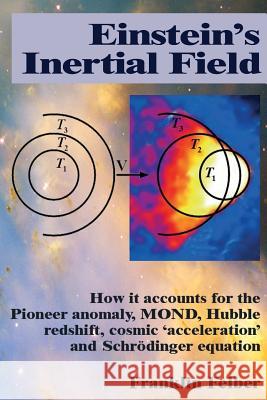Einstein's Inertial Field: How it accounts for the Pioneer anomaly, MOND, Hubble redshift, cosmic 'acceleration' and Schrodinger equation » książka
Einstein's Inertial Field: How it accounts for the Pioneer anomaly, MOND, Hubble redshift, cosmic 'acceleration' and Schrodinger equation
ISBN-13: 9781530313662 / Angielski / Miękka / 2016 / 176 str.
Einstein's Inertial Field: How it accounts for the Pioneer anomaly, MOND, Hubble redshift, cosmic 'acceleration' and Schrodinger equation
ISBN-13: 9781530313662 / Angielski / Miękka / 2016 / 176 str.
(netto: 86,93 VAT: 5%)
Najniższa cena z 30 dni: 85,56 zł
ok. 13-18 dni roboczych.
Darmowa dostawa!
Einstein's Inertial Field presents for the first time anywhere new exact solutions of Einstein's equation of general relativity. The new solutions confirm Einstein's long-held belief that the foundations of inertia are already embedded in his theory of gravitation. The solutions reveal a wealth of information about our universe and seem to account for a wide variety of anomalous phenomena that have been observed over the past several decades. These phenomena range in scale from our solar system to the farthest reaches of the cosmos. Remarkably, the new solutions suggest that Einstein's inertial field accounts for these diverse phenomena in an Einstein static universe, one that is neither expanding nor contracting. The book is written clearly with lots of exposition supporting the mathematical development and with equations developed step-by-step. The hope is that you will come to appreciate that Einstein's century-old masterpiece, his original theory of general relativity with no modifications, still has a world of new insights to offer into our understanding of our universe. ABSTRACT: New exact solutions of Einstein's equation for a static universe with discrete masses reveal the existence of an inertial field. The new solutions feature an inertial time dilation that results in an event horizon in a static, nearly flat universe at a radius of 13.8+/-1.2 billion light-years. Associated with the inertial field is a 4-vector inertial-drag force proportional to an invariant scalar acceleration. The inertial field accounts for anomalies at the scale of our solar system and at galactic and cosmological scales. Inertial time dilation accounts for the constant component of the Pioneer anomaly, but has no discernible effect on the precession rate of planetary orbits. In clusters and galaxies, the inertial field accounts indirectly for such effects as flat rotation curves, the Tully-Fisher relation, and the limit on mean surface brightness of spiral galaxies. The effect of the inertial drag force on hot plasmas offers an alternative interpretation of the Bullet cluster. The inertial field also accounts for the Hubble redshift and the appearance of cosmic acceleration in a static Einstein universe. With no adjustable parameters, inertial time dilation and inertial drag account completely for Type Ia supernova pulse data in a static universe. Acceleration of a mass produces dipole inertial radiation. Fluctuations of the cosmic inertial radiation background can account for all the quantum mechanical effects described by the Schrodinger wave equation. The power spectral density of inertial noise is calculated. The possibility that the inertial field is quantized and might be mediated by a massless spin-1 boson is discussed."











